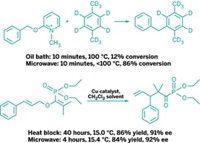Advertisement
Grab your lab coat. Let's get started
Welcome!
Welcome!
Create an account below to get 6 C&EN articles per month, receive newsletters and more - all free.
It seems this is your first time logging in online. Please enter the following information to continue.
As an ACS member you automatically get access to this site. All we need is few more details to create your reading experience.
Not you? Sign in with a different account.
Not you? Sign in with a different account.
ERROR 1
ERROR 1
ERROR 2
ERROR 2
ERROR 2
ERROR 2
ERROR 2
Password and Confirm password must match.
If you have an ACS member number, please enter it here so we can link this account to your membership. (optional)
ERROR 2
ACS values your privacy. By submitting your information, you are gaining access to C&EN and subscribing to our weekly newsletter. We use the information you provide to make your reading experience better, and we will never sell your data to third party members.
Environment
Microwaves Confirmed To Enhance Reaction Rates
Microwave-driven continuous microreactors could prove useful for small-scale industrial processes
by Stephen K. Ritter
January 26, 2006
Microwave ovens have become popular tools to facilitate chemical reactions, but it has been unclear if observed enhanced reaction rates result from rapid heating or from interactions of microwaves with the bonds of the reactants. Roshan Jachuck and Dinesh K. Selvaraj of Clarkson University, Potsdam, N.Y., and Rajender S. Varma of EPA's National Risk Management Research Laboratory, Cincinnati, have now shown that microwave radiation indeed has a significant impact on reaction rates (Green Chem. 2006, 8, 29).
Microwave reactions typically are carried out in a vessel placed inside a commercial microwave oven—a batch reaction. As part of Jachuck's work on industrial process intensification, however, his group in the department of chemical and biomolecular engineering designed a continuous capillary microreactor that can be maintained at a constant temperature while being irradiated with microwaves. The researchers used the reactor to study the iron-catalyzed conversion of benzyl alcohol to benzaldehyde.
The reactor produced benzaldehyde in about 75% yield under optimized conditions, which equated to a reaction time of about 15 seconds and a flow rate of about 1 mL/minute. The key observation was that increasing the microwave intensity at constant temperature increased the yield of benzaldehyde, Jachuck notes.
The researchers are looking for possible business partners to commercialize their microwave microreactors, including versions that would allow tuning the microwave frequency for specific reactions, Jachuck says. He envisions that the reactors could be used for lab- or pilot-scale projects or even for production of low-volume pharmaceutical active ingredients.




Join the conversation
Contact the reporter
Submit a Letter to the Editor for publication
Engage with us on Twitter